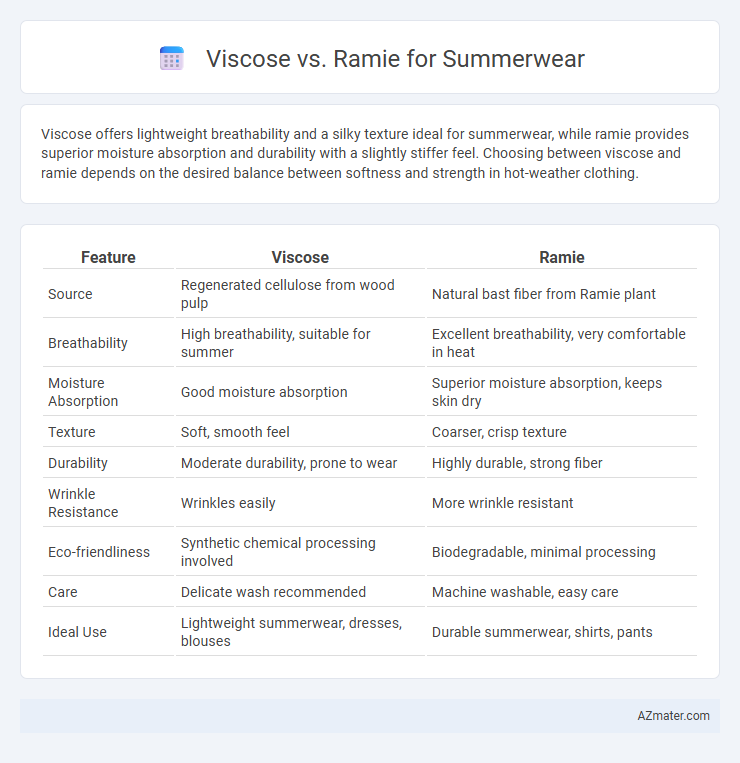Viscose offers lightweight breathability and a silky texture ideal for summerwear, while ramie provides superior moisture absorption and durability with a slightly stiffer feel. Choosing between viscose and ramie depends on the desired balance between softness and strength in hot-weather clothing.
Table of Comparison
| Feature | Viscose | Ramie |
|---|---|---|
| Source | Regenerated cellulose from wood pulp | Natural bast fiber from Ramie plant |
| Breathability | High breathability, suitable for summer | Excellent breathability, very comfortable in heat |
| Moisture Absorption | Good moisture absorption | Superior moisture absorption, keeps skin dry |
| Texture | Soft, smooth feel | Coarser, crisp texture |
| Durability | Moderate durability, prone to wear | Highly durable, strong fiber |
| Wrinkle Resistance | Wrinkles easily | More wrinkle resistant |
| Eco-friendliness | Synthetic chemical processing involved | Biodegradable, minimal processing |
| Care | Delicate wash recommended | Machine washable, easy care |
| Ideal Use | Lightweight summerwear, dresses, blouses | Durable summerwear, shirts, pants |
Introduction to Viscose and Ramie Fabrics
Viscose and ramie are popular natural fibers used in summerwear due to their breathability and moisture-absorbing properties. Viscose, a semi-synthetic fiber made from regenerated cellulose, offers a smooth texture and excellent drape that enhances comfort in hot weather. Ramie, a bast fiber derived from a flowering plant, is known for its strength, durability, and natural luster, making it ideal for lightweight and breathable summer clothing.
Origins and Production Processes
Viscose is a semi-synthetic fiber derived from regenerated cellulose, primarily sourced from wood pulp through a chemical process involving carbon disulfide and sodium hydroxide. Ramie, a natural bast fiber, originates from the stalks of the Ramie plant (Boehmeria nivea) and undergoes mechanical and chemical retting to extract its long, lustrous fibers. Both fibers offer breathability and moisture absorption, but ramie's production is more labor-intensive and eco-friendly compared to viscose's chemically intensive method.
Breathability and Comfort in Hot Weather
Viscose offers excellent breathability and moisture absorption, making it a popular choice for summerwear designed to keep the skin cool and dry. Ramie, derived from the nettle plant, excels in durability and provides superior ventilation, offering a crisp, lightweight feel ideal for hot weather. Both fabrics enhance comfort in high temperatures, but Ramie tends to maintain its shape and resist wrinkles better, while Viscose delivers a softer texture against the skin.
Moisture-Wicking and Absorbency
Viscose and ramie are both popular fibers for summerwear due to their moisture-wicking and absorbent properties. Ramie offers superior moisture-wicking abilities, drawing sweat away from the skin quickly and keeping the wearer dry and comfortable in hot, humid conditions. Viscose, while absorbent and breathable, tends to retain moisture longer, making ramie a preferred choice for enhanced sweat management in summer garments.
Softness and Skin Feel
Viscose offers exceptional softness and a smooth texture that feels gentle on the skin, making it ideal for summerwear that prioritizes comfort. Ramie, while also breathable and lightweight, has a slightly coarser texture compared to viscose, which can affect the overall softness experienced against sensitive skin. Choosing viscose for summer garments ensures a luxurious, silky touch, whereas ramie is valued for its durability and crisp feel despite being less soft.
Durability and Longevity
Viscose offers a soft, breathable fabric ideal for summerwear but tends to be less durable and prone to weakening when exposed to moisture and frequent washing. Ramie, a natural bast fiber, excels in durability and longevity due to its strong cellulose structure, maintaining shape and resistance to wear over time. For sustained use, ramie garments outperform viscose in retaining strength and providing long-lasting comfort in warm climates.
Environmental Impact and Sustainability
Viscose, derived from wood pulp, often involves chemical-intensive processing that raises concerns about water pollution and deforestation, whereas ramie, a natural fiber from the stalks of the Boehmeria plant, typically requires fewer chemicals and less water, making it more eco-friendly. Ramie's strong, durable fibers lend themselves well to reusable and long-lasting garments, contributing to sustainability by reducing textile waste. Choosing ramie over viscose for summerwear supports lower environmental impact due to its biodegradable properties and more sustainable cultivation practices.
Style, Drape, and Aesthetics
Viscose offers a smooth, silky texture with excellent drape that flatters summer silhouettes, providing a sleek and elegant aesthetic ideal for flowy dresses and blouses. Ramie features a natural luster and crisp hand, adding structure and a slightly stiffer drape that enhances casual, breathable summer garments with a refined yet rustic charm. Both fibers excel in breathability and moisture-wicking, but viscose leans towards luxurious softness while ramie emphasizes durability and a textured finish.
Care and Maintenance Requirements
Viscose requires gentle hand washing or machine washing on a delicate cycle with cold water to prevent shrinking or damage, while Ramie is more durable and can withstand regular machine washing without losing its texture. Both fabrics benefit from air drying to maintain shape and reduce the risk of fabric weakening caused by heat. Ironing should be done on a low heat setting for viscose and a slightly higher heat for Ramie to smooth wrinkles without damaging the fibers.
Conclusion: Choosing the Best Summer Fabric
Viscose offers a soft, breathable texture with excellent moisture absorption, making it ideal for lightweight summerwear that drapes well. Ramie provides superior durability and natural anti-bacterial properties, combined with a crisp feel that resists wrinkles, perfect for structured summer garments. Selecting between viscose and ramie depends on the balance of comfort, breathability, and fabric longevity required for your specific summer wardrobe needs.

Infographic: Viscose vs Ramie for Summerwear
 azmater.com
azmater.com